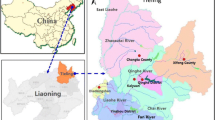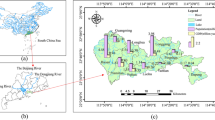Abstract
Water environmental issues result from problems between the socio-economic system and the water environmental system. The concept of water environmental carrying capacity (WECC) can be used to describe water environmental system’s capacity which supports socio-economic development, and examine the trade-off between the driver/pressure (socio-economic) and the support (environmental) components of the societal-environmental interactive system. At the same time, an objective assessment of WECC may provide feasible integrated solutions for resolving water-related environmental problems. Hence, the quantitative assessment of WECC should be based on best available scientific knowledge coupled with appropriate simulation of complex interactions between the society and the environment. For this reason, this paper develops a WECC assessment method (WECC-SDM) which is based on a system dynamics framework. WECC-SDM can dynamically compute the WECC under different societal and environmental scenarios through coevolution and systematic simulations of the society–economy–water environment interactions. The WECC-SDM-based WECC assessment is, in fact, an interactive yet adaptive process of diagnosis–adjustment–improvement, which may provide helpful information for the sustainable development of river basins. The application of WECC-SDM shows that WECC in Tieling (in Northwest China) was severely overloaded in 2012 due to heavy ammonia nitrogen pollution in the dry season, which matches actual observations. The model was subsequently used to predict the situation of Tieling for the next 20 years. However, if positive actions in line with positive socio-economic development are taken to prevent and control pollution, it is possible for Tieling to revert back to a positive WECC situation in 2028, and support a population of 3.17 million and a GDP of 314.8 billion Yuan. As shown by the case study of Tieling, WECC-SDM can make a reasonable assessment of the current situation and simulate the trends of different scenarios, and is thus a practical WECC assessment tool.






Similar content being viewed by others
References
Aguilar JAP, Andreu V, Vázquez P, Picó Y (2014) Presence and spatial distribution of emerging contaminants (drugs of abuse) in protected agroecological systems (L’Albufera de Valencia Coastal Wetland, Spain). Environ Earth Sci 71(1):31–37
Antonellini M, Dentinho T, Khattabi A, Masson E, Mollema PN, Silva V, Silveira P (2014) An integrated methodology to assess future water resources under land use and climate change: an application to the Tahadart drainage basin (Morocco). Environ Earth Sci 71(4):1839–1853
Arrow K, Bolin B, Costanza R, Dasgupta P, Folke C, Holling CS, Jansson BO, Levin S, Mäler KG, Perrings C, Pimentel D (1995) Economic growth, carrying capacity, and the environment. Ecol Econ 15:89–90
Bagdanavičiūtė I, Valiūnas J (2013) GIS-based land suitability analysis integrating multi-criteria evaluation for the allocation of potential pollution sources. Environ Earth Sci 68(6):1797–1812
Bu H, Wan J, Zhang Y, Meng W (2013) Spatial characteristics of surface water quality in the Haicheng River (Liao River basin) in Northeast China. Environ Earth Sci 70(6):2865–2872
Cuadra M, Björklund J (2007) Assessment of economic and ecological carrying capacity of agricultural crops in Nicaragua. Ecol Indic 7:133–149
Davies EG, Simonovic SP (2011) Global water resources modeling with an integrated model of the social-economic-environmental system. Adv Water Resour 34(6):684–700
Gong L, Jin CL (2009) Fuzzy comprehensive evaluation for carrying capacity of regional water resources. Water Resour Manag 23(12):2505–2513
Holz CA (2008) China’s economic growth 1978–2025: what we know today about China’s economic growth tomorrow. World Dev 36(10):1665–1691
Huang H, Lu J (2014) Identification of river water pollution characteristics based on projection pursuit and factor analysis. Environ Earth Sci 72:1–9
Hubacek K, Guan D, Barrett J, Wiedmann T (2009) Environmental implications of urbanization and lifestyle change in China: ecological and water footprints. J Clean Prod 17(14):1241–1248
Huo A, Li H (2013) Assessment of climate change impact on the stream-flow in a typical debris flow watershed of Jianzhuangcuan catchment in Shaanxi Province, China. Environ Earth Sci 69(6):1931–1938
Jia YW, Wang H, Zhou ZH, Qiu YQ, Luo XY, Wang JH, Yan DH, Qin DY (2006) Development of the WEP-L distributed hydrological model and dynamic assessment of water resources in the Yellow River Basin. J Hydrol 331(3):606–629
Jiao W, Xu Z (2013) A distributed runoff model for the mountainous region of the Heihe River Basin (China) based on the spatial modeling environment (SME) I: model structure and equations. Environ Earth Sci 68(3):881–888
Li M (2012) Study on estimation and allocation method of river water environmental capacity for Liaohe River in Tieling. Shenyang University of Technology Press, Shenyang, pp 45–64 (in Chinese)
Liu RZ, Borthwick AG (2011) Measurement and assessment of carrying capacity of the environment in Ningbo, China. J Environ Manag 92(8):2047–2053
Pandey VP, Babel MS, Shrestha S, Kazama F (2011) A framework to assess adaptive capacity of the water resources system in Nepalese river basins. Ecol Indic 11:480–488
Qin HP, Su Q, Khu ST (2011) An integrated model for water management in a rapidly urbanizing catchment. Environ Model Softw 26(12):1502–1514
Rahman K, Etienne C, Gago-Silva A, Maringanti C, Beniston M, Lehmann A (2014) Streamflow response to regional climate model output in the mountainous watershed: a case study from the Swiss Alps. Environ Earth Sci 72:1–13
Sterman JD (1994) Learning in and about complex systems. Syst Dyn Rev 10(2–3):291–330
Tieling Municipal Bureau of Statistics (2012) Tieling statistical yearbook. Tieling Municipal Bureau of Statistics, Tieling (in Chinese)
Tieling Municipal Bureau of Water Resources (2012) Water resources bulletin of Tieling. Tieling Municipal Bureau of Water Resources, Tieling (in Chinese)
Wan J, Bu H, Zhang Y, Meng W (2013) Classification of rivers based on water quality assessment using factor analysis in Taizi River basin, northeast China. Environ Earth Sci 69(3):909–919
Wang S, Xu L, Yang F, Wang H (2014) Assessment of water ecological carrying capacity under the two policies in Tieling City on the basis of the integrated system dynamics model. Sci Total Environ 472:1070–1081
Winz I, Brierley G, Trowsdale S (2009) The use of system dynamics simulation in water resources management. Water Resour Manag 23(7):1301–1323
Yang JF, Lei K, Qiao F (2014a) Research on water ecological carrying capacity: progress and puzzles. Adv Mater Res 869:634–639
Yang JF, Lei K, Qiao F (2014b) An improved index system of regional water ecological carrying capacity evaluation: a case study of Tieling City, China. Adv Mater Res 869:627–633
Zhang X, Xu K, Zhang D (2012) Risk assessment of water resources utilization in Songliao Basin of Northeast China. Environ Earth Sci 67(5):1319–1329
Zhang Z, Lu WX, Zhao Y, Song WB (2014) Development tendency analysis and evaluation of the water ecological carrying capacity in the Siping area of Jilin Province in China based on system dynamics and analytic hierarchy process. Ecol Model 275:9–21
Acknowledgments
This work was financially supported by the Chinese National Specialised Projects for the Control and Treatment Technology of Water Pollution (Project number: 2013ZX07501-005).
Author information
Authors and Affiliations
Corresponding author
Rights and permissions
About this article
Cite this article
Yang, J., Lei, K., Khu, S. et al. Assessment of water environmental carrying capacity for sustainable development using a coupled system dynamics approach applied to the Tieling of the Liao River Basin, China. Environ Earth Sci 73, 5173–5183 (2015). https://doi.org/10.1007/s12665-015-4230-0
Received:
Accepted:
Published:
Issue Date:
DOI: https://doi.org/10.1007/s12665-015-4230-0




